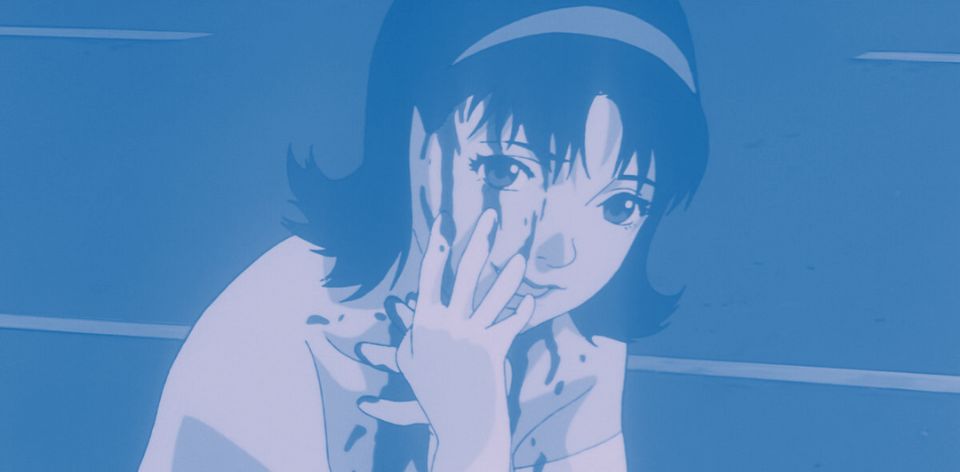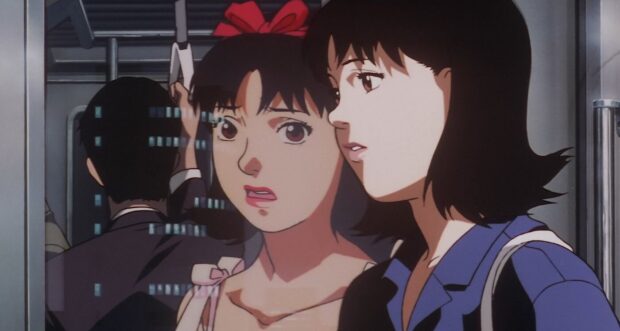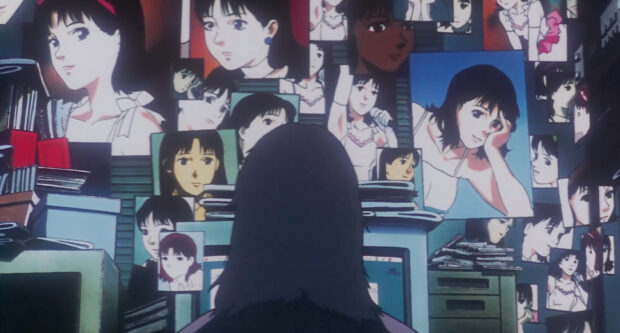“Why do all psycho thrillers in Japan turn out the same way?”
Outsiders might have said the same about anime at a certain point in the 1990s. Following the launch of Neon Genesis Evangelion on an unsuspecting world, Japanese and international audiences were being treated to a plethora of organic mecha and super robot shows.
Yet there was a parallel movement that saw global festival and cult audiences, perhaps on the hunt for the next Twin Peaks, searching out shows like Serial Experiments Lain. In the same year Hayao Miyazaki’s Princess Mononoke (1997) became the most-expensive anime film up until that time, Satoshi Kon’s debut film PERFECT BLUE (パーフェクトブルー) won Best Film and Best Animation awards at Montreal’s 1997 Fantasia Festival.
‘A rape scene? You have got to be out of your mind!’
Based on Yoshikazu Takeuchi’s novel Perfect Blue: Complete Metamorphosis, the film opens on the performance of J-pop idol group CHAM. Its leading light Mima (voiced by Junko Iwai) is about to ‘graduate’ from the group to pursue a solo acting career. Yet an obsessive stalker isn’t happy with the change, watching her every move and posting it as an online diary. When the people around her are violently murdered, her sense of reality is shaken to the core.
While Kon’s debut is often considered groundbreaking for the number of boundaries it pushes, it’s remarkable for just how close to reality it actually was. For a medium that was known for bringing unreal things to life, here is a film that mirrors the darker aspects of our world. From the opening scene, in which photographers and fans alike mindlessly snap away at the CHAM performance, the thin line between the public and private lives of a celebrity are blurred.
In many ways, PERFECT BLUE anticipated a more sinister age of celebrities and the perils of being ‘always on.’ Even if the MiniDiscs and faxes mark the film as a product of its time — and someone has to explain the Internet to Mima at one point — it could almost be an early commentary on social media. Kon’s ability to get into the dark mind of the cult of celebrity seems to come from a very real place. In the recent documentary Satoshi Kon: The Illusionist, actress Junko Iwai discusses how her own time as an idol and the experience of being stalked influence the character.
So, when people talk about the ground that Kon broke, it was in his dissection of those well-known tropes. In the wake of the ultra-violent films like Ninja Scroll (1993) or the Genocyber (1994) series, not to mention the notorious sexualised violence of Urotsukidōji (1987), Kon’s sequences are based in more of a grim reality. Yes, there is an argument that Kon, much like Paul Verhoeven, uses rape merely as a narrative device. PERFECT BLUE is full of examples of the male gaze, not least of which is a nude photo shoot that is used repeatedly throughout the film.
Yet the first instance of rape on screen is within the context of Double Bind, the film within a film that Mima is shooting. As the scene is shot over several takes, Kon slides out of any accusations of sensationalism by making us consider the moment for what it is: a deliberate deconstruction crafted in a studio for our entertainment. Kon is calling out the kinds of sex and violence that made the pearl-clutchers reach for the smelling salts, both in Japan and Hollywood, while pointing out our collective complicity in its perpetuation.
“But illusions don’t kill.”
By this stage in the film, Kon has conclusively introduced the notion of duality. Just as David Lynch’s contemporaneous Lost Highway (1997) explored the fluidity between recorded memory and the event, PERFECT BLUE also crafts a thriller within the framework of identity, voyeurism and the notion of multiple selves.
For much of the film, Kon and screenwriter Sadayuki Murai keep events deliberately ambiguous. When Mima is first introduced, we already see her ‘other’ self reflected in a train window. Later, she sees a reflection of herself in her idol outfit claiming to be the ‘real’ Mima. As the events of the film escalate, it becomes unclear whether Mima is seeing another self or is committing crimes while in a fugue state. This is exacerbated by the film constantly segueing in and out of the similarly themed Double Bind, confusing the lines between fiction and reality even further.
The ambiguity continues right through the gripping climax to the almost dreamlike ending. Following an attempted rape by her stalker Me-Mania, it is revealed that Mima’s agent Rumi — herself a former idol seeking to relive her glory — has been manipulating both Mima and Me-Mania. Rumi even began to believe that she was the real Mima in a kind of shared delusional disorder. In the final scenes, a more assertive Mima visits Rumi in a mental health facility, the latter having now completely succumbed to her delusions. As staff mistake Mima for an impersonator, the now successful star reassures herself in her car’s rear-view mirror that “No, I’m the real thing.”
“The pop idol image is suffocating me…”
We lost Satoshi Kon in 2010 after a brief battle with pancreatic cancer. In his short but significant career, he also released Millennium Actress (2001), Tokyo Godfathers (2003), Paprika (2006) and the TV series Paranoia Agent, described as his answer to Twin Peaks. He may not have been as recognised in his time as he would have like, but 25 years after his debut we can reflect on how he ushered in a new era of adult storytelling in anime. “Satoshi Kon broadened the scope of animation,” Mamoru Hosoda (Summer Wars, Belle) once declared.
UK critic Andrew Osmond, author of the 2009 biography of the filmmaker, draws a parallel between PERFECT BLUE and David Lynch’s Mulholland Drive (2001). In candid moments, Darren Aronofsky points to iconic shots (such as Mima in a bathtub) that he ‘borrowed’ for Requiem for a Dream (2000). Indeed, the embedded video above leaves little doubt as to the influence. You can see that influence even more clearly in his later Black Swan (2010) and Nicolas Winding Refn’s The Neon Demon (2015).
So, while we may look back on aspects of this and see it as a product of the late 1990s, it continues to transcend any sense of time and place. Kon returned to some of these themes in the arguably superior Millennium Actress, another film where the lines between cinema and reality have blurred. In an age when entire fandoms are built around brand identities, and social media has made it easier than ever to get lost in alternate identities, maybe Kon was just 25 years ahead of his time.






